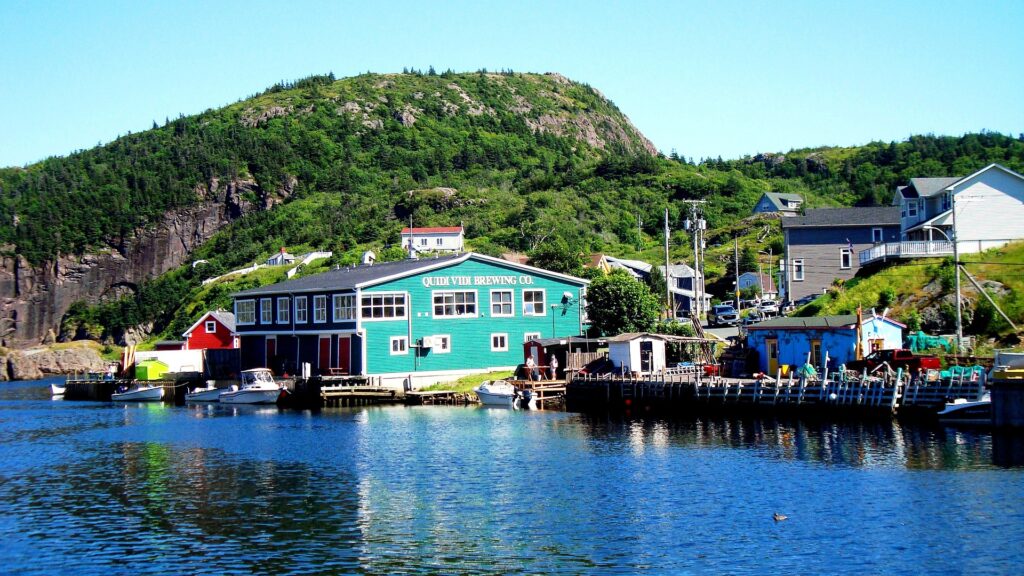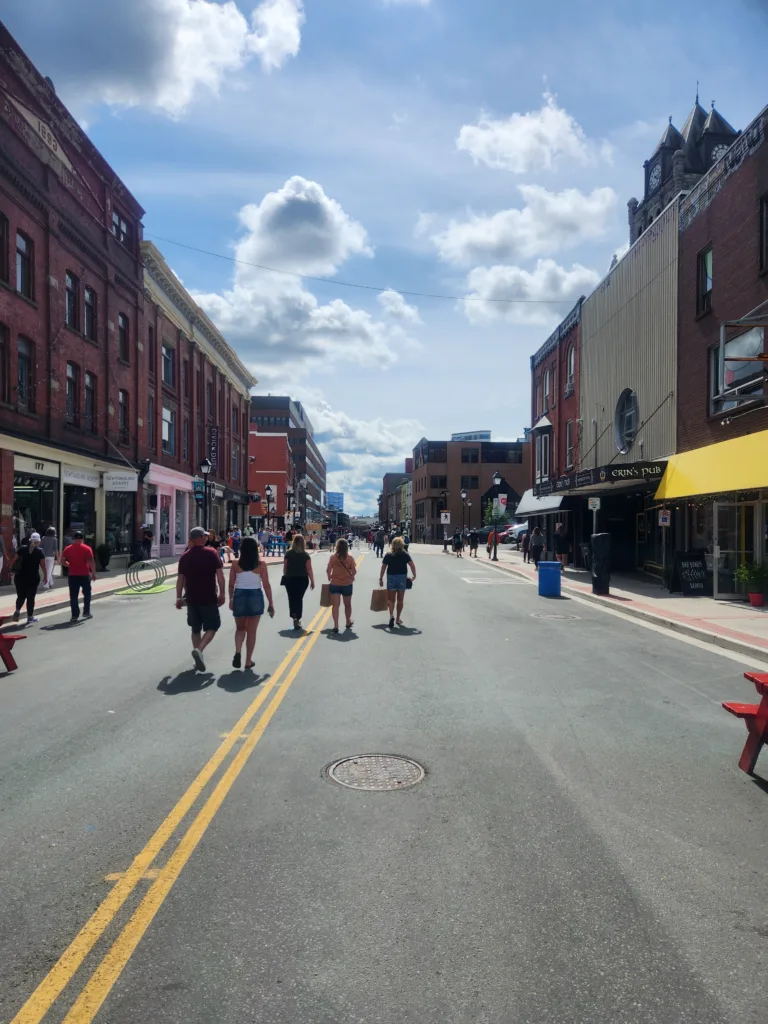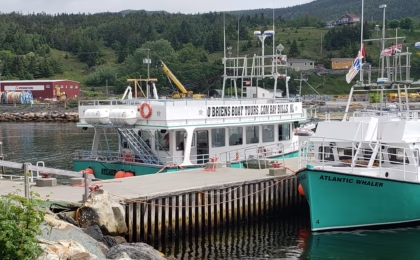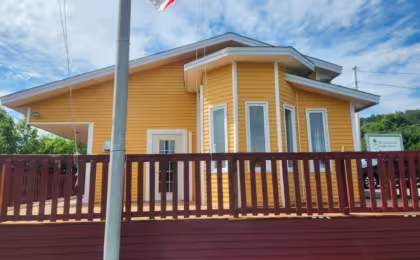Exploring The Beautiful City of St John’s
Exploring The Beautiful City of St John’s: A Comprehensive Guide to Must-Do Activities. St. John’s, the vibrant capital of Newfoundland and Labrador, has a unique blend of natural beauty, rich history, and a thriving cultural scene. Whether you arrive on a cruise ship, Fly in through St John’s International Airport, or on the Marine Atlantic Ferry, St. John’s has something for everyone. This travel guide will explore the top 20 things to do in this captivating city of culture, colours, history, and good food.
1. Signal Hill National Historic Site

This Hill is a historic site and a place to enjoy breathtaking views of the Atlantic Ocean. Explore the Cabot Tower and learn about its history.
Signal Hill is synonymous with historical significance. It’s known for receiving the first transatlantic wireless signal, marking a milestone in global communication. But its historical roots run even more profound. The hill has been a site of military significance for centuries, with its fortifications dating back centuries. One of the most iconic things to see on Signal Hill is Cabot Tower, a stone structure that stands as a testament to the hill’s historical importance and grandeur.
The tower offers panoramic views of the Atlantic Ocean and St. John’s Harbour. The most Unique thing to do in St John’s is climb to the top of Cabot Tower, where the vistas will take your breath away. Signal Hill is not just a historical and natural wonder. It’s also a hub for cultural events and celebrations. Signal Hill site hosts numerous events throughout the year, including Canada Day celebrations, historical reenactments, and outdoor concerts. Visitors get to immerse themselves in the culture and traditions of Newfoundland and Labrador.
Location: Signal Hill is in St. John’s, Newfoundland and Labrador.
Operating Hours: The site is open year-round, with varying hours depending on the season.
Admission: There is no admission fee.
Hiking Signal Hill Trail, North Head
This trail offers beautiful views of St. John’s. Hiking North Head Trail Signal Hill is a challenging hike that takes about 1 hour to complete.
North Head Trail begins at the parking lot of Signal Hill, or you can park at the Visitor Center, where a café shop and water are available. You can walk from the visitor center to the top of Signal Hill to begin your hiking downhill hike. The trail winds down the side of Signal Hill before arriving at an open area, which gives you the full view of the Narrow and Atlantic oceans. From there, hikers can continue to the side of Signal Hill for a spectacular view of the city and harbour. While the hike is relatively easy, it requires some climbing and navigating rocky terrain, so hikers should be comfortable with those aspects before attempting this trail.
2. Johnson Geo Centre

Address: 175 Signal Hill Road, St. John’s, NL
Another thing to do in St John’ is to Delve into the Earth’s history at the Geo Centre, where you can explore the planet’s geological wonders. The Johnson Geo Centre is nested on the hillside of Signal Hill. We will delve deep into what makes the Johnson Geo Centre a must-visit destination. The Johnson Geo Centre is a unique attraction built into the ancient rock of Signal Hill, providing an immersive experience that showcases the Earth’s evolution over billions of years. The Johnson Geo Centre boasts an impressive array of exhibits and galleries that educate and captivate visitors of all ages. The Centre offers a comprehensive understanding of Earth sciences, from interactive displays to thought-provoking installations. One of the most remarkable aspects of the Johnson Geo Centre is its focus on the unique geology of Newfoundland. The exhibit transports visitors on a journey through time, exploring the geological forces shaping this island’s landscapes. The Geo Centre is a family-friendly destination. Its interactive exhibits and engaging displays ensure visitors have a fun and educational experience. The Johnson Geo Centre is located within Signal Hill, adding to its appeal. After exploring the Centre, visitors can ascend Signal Hill and enjoy panoramic views of St. John’s and the Atlantic Ocean.
3. Quidi Vidi Village

This charming fishing village is known for its colourful houses, craft breweries, and the annual Regatta. This one will be your favourite of all the things to do in St John’s, Newfoundland. When you get to Quidi Vidi Village, Explore the local culture and enjoy a pint by the harbour. Nestled on the eastern edge of Newfoundland and Labrador, Quidi Vidi Village is a hidden gem that offers travellers a taste of quintessential Newfoundland charm. Quidi Vidi, a picturesque village, is known for its scenic beauty, cultural richness, and historical significance. To truly understand the essence of Quidi Vidi Village, one must delve into its storied past.
Quidi Vidi Gut: The heart of the village is the Quidi Vidi Gut, a natural harbour surrounded by towering cliffs. This picturesque setting is perfect for leisurely walks and provides a glimpse of traditional fishing activities. The Quidi Vidi Plantation, a craft center, is located here and allows visitors to witness artwork.
Quidi Vidi Brewery: A visit to the Quidi Vidi Brewery is a must for beer enthusiasts. It’s known for its craft beers, including the famous Iceberg Beer. Take a brewery tour, learn about beer-making, and enjoy a tasting session. The Plantation: Located in the heart of the village, The Plantation is an artist’s haven. It’s home to various artisans, including potters, weavers, and printmakers. Visitors can purchase unique, handcrafted souvenirs and be awed by the creative process.
Quidi Vidi Lake: The village is not just about the sea; it’s also home to the stunning Quidi Vidi Lake, surrounded by a beautiful walking trail. Nature enthusiasts will love the serenity of this place and the opportunity to spot various bird species.
The Regatta: The Royal St. John’s Regatta is a summer tradition in Quidi Vidi Village. It’s one of North America’s oldest annual sporting events, featuring rowing races, live music, and plenty of food and drink. Hiking: Quidi Vidi offers fantastic hiking opportunities, whether a stroll around the village or a more challenging hike on the East Coast Trail, which passes through the area. Cultural Experiences: Learn about the local culture by attending events like the Mummers Festival, which celebrates Newfoundland unique tradition. This event takes place in St John’s. Seafood Dining: Quidi Vidi is famous for its seafood, and you can savour the freshest catches at local restaurants. Remember to try the iconic fish and chips!
More Newfoundland and Labrador Travel Guides
- The 3 Most Beautiful Places In St. John’s We Visited.
- Five days guide around St John’s
- Discover The Most Beautiful Places In St. John’s Tourist Visit
- Exploring the Best Charm of St. John’s, Newfoundland
- The best 14 things to do in St. John’s
- How To Book The 20 Top Rated Attractions and Things To Do In St. John’s
4. The Rooms

Address: 9 Bonaventure Avenue, St. John’s, NL
Discover Newfoundland and Labrador’s history, art, and culture in this striking museum and art gallery. It’s a treasure trove of information and inspiration. Nestled in the heart of St. John’s, Newfoundland, The Rooms Museum is a cultural treasure encapsulating this eastern Canadian province’s rich history and diverse heritage. The Rooms Museum serves as a guardian of Newfoundland heritage.
The museum offers a comprehensive look at the province’s history with exhibits that trace the province’s roots from the Indigenous Beothuk and Mi’kmaq peoples to the early European explorers, such as John Cabot. One of the standout features of The Rooms is its vibrant art and culture collection. Newfoundland artistic spirit is celebrated through various galleries and exhibits. Local artists have crafted works that depict the province’s natural beauty and the unique cultural experiences of its residents.
The Rooms Museum offers a captivating journey into the past. The museum showcases remarkable artifacts and discoveries from excavations across Newfoundland and Labrador. These findings shed light on the province’s prehistoric and historic eras. The Rooms Museum is more than just a repository of historical and cultural artifacts. It’s also a hub of learning and discovery. The museum’s educational programs are designed to engage all visitors, making it an ideal destination for families, students, and tourists. Apart from its cultural and historical offerings, The Rooms provides a breathtaking view of St. John’s and the surrounding area. Situated on a hill on Bonaventure Avenue overlooking the harbour, the museum offers a stunning panorama of the city, the Atlantic Ocean, and the picturesque landscape Newfoundland is known for.
5. George Street
For nightlife and live music, George Street is the place to be. This lively Street is known for its vibrant pubs and entertainment options. Newfoundland and Labrador, Canada, boasts a wealth of remarkable destinations, but none quite as enthusiastic and culturally rich as George Street.
This iconic Street, in the heart of St. John’s, the provincial capital, has earned a reputation as one of the country’s most vibrant and captivating entertainment districts. George Street is a narrow, pedestrian-only thoroughfare in downtown St. John’s, Newfoundland. Its unique charm stems from its countless pubs, bars, restaurants, and vibrant music scene. George Street’s atmosphere is electric, coming alive every night of the week, making it a must-visit destination for tourists and locals.
6. Water Street

Stroll along Water Street and explore local shops, boutiques, and restaurants, offering a taste of the city’s unique character. One of the most iconic streets in this captivating city is Water Street. Stretching adjacent to the harbourfront, Water Street is a bustling activity hub with historical buildings dotted along the side of the Street.
This Street is a shopper’s paradise, offering an array of boutiques, art galleries, restaurants, bars and antique shops. You can find unique, locally-made treasures and Newfoundland crafts that make for fantastic souvenirs. After shopping, explore the culinary delights this Street has to offer. From traditional Newfoundland seafood restaurants to international cuisine, you’ll find something to please your palate.
Throughout the year, Water Street hosts various events and festivals. Downtown Pedestrian Mall is open from June until September. The celebration of music and culture spills over into Water Street, making it the place to be in the summer. Water Street is accessible to pedestrians only when the Downtown Pedestrian Mall is open. Visitors can walk freely and enjoy food and drink on patios.
Water Street in St. John’s, Newfoundland, is a vibrant, historical, and culturally rich destination that offers something for everyone. This iconic Street has everything if you’re interested in history, shopping, dining, or outdoor adventures. As you explore Water Street, you’ll discover the essence of Newfoundland and Labrador’s charm. It’s a place where history and modernity coexist harmoniously, creating a unique experience for every visitor.
7. Jellybean Row Houses

Admire the colourful row houses that line the streets of St. John’s, affectionately known as “Jellybean Row.” These make for great photo opportunities. Jellybean Row Houses in St. John’s, Newfoundland, symbolizes the city’s rich history and artistic flair. These colourful houses, arrayed like candies in a jar, offer an unparalleled visual delight.
A unique and charming architectural phenomenon awaits travellers and history enthusiasts. The Jellybean Row Houses, often dubbed ‘Jellybean Row,’ are a captivating collection of brightly coloured homes that line the city’s winding streets. The Jellybean Row Houses are not just pretty faces. They hold a deep cultural significance for the people of St. John’s. The residents take great pride in maintaining the vibrancy of their homes. It’s common to find local artists during a paint job, ensuring that the houses continue shining brightly and preserving their cultural legacy.
As a traveller, you can immerse yourself in the charm of Jellybean Row by taking a stroll through its winding streets. Many guided tours provide an in-depth look at the history and cultural tales associated with these houses. Local guides often regale visitors with stories passed down through generations.
8. Bannerman Park
A peaceful escape in the city’s heart, Bannerman Park offers short walking trails, a playground, and an area for picnics. Families and young visitors will be delighted by the park’s state-of-the-art playgrounds, which provide endless fun and excitement. These modern play areas are equipped with safe, age-appropriate equipment, ensuring that children of all ages can enjoy themselves. Picnic areas and benches are conveniently scattered throughout the park, creating perfect spots for a leisurely lunch or a quiet moment of reflection.
Bannerman Park is not only a natural paradise but also a cultural hub. The park features an outdoor skating ring called The Loop that allows for skating in the winter. Enjoy moments of tranquillity at Bannerman Park. The park is perfect for yoga and meditation, where you can practice mindfulness amidst the natural beauty of the surroundings. This makes it an ideal destination for those seeking wellness and mental rejuvenation.
Bannerman Park is conveniently located in the heart of St. John’s, making it easily accessible by foot, bike, or car.
9. Basilica of St. John the Baptist
Visit this stunning basilica, an architectural masterpiece and a significant religious site.

Can you see icebergs in Newfoundland now?
Icebergs are typically seen off the coast of Newfoundland from late spring to early summer. The best months for iceberg viewing are usually May and June. If it’s within this timeframe, you can likely see icebergs, especially in areas like Twillingate and St. Anthony.
When to see icebergs in Twillingate?
The prime time to see icebergs in Twillingate is from late May to early June. This period offers the highest likelihood of witnessing these massive ice formations as they drift southward along the coast.
Where is the best place to see icebergs?
The best places to see icebergs in Newfoundland include Twillingate, St. Anthony, Bonavista, and Fogo Island. Twillingate is often called the “Iceberg Capital of the World” due to its high iceberg count and accessibility.
What is the best month to see icebergs in Newfoundland?
The best month to see icebergs in Newfoundland is May. During this month, the icebergs are plentiful, and the weather is often more favourable for boat tours and coastal viewing.
How long do icebergs last in Newfoundland?
Icebergs can last from a few weeks to several months in Newfoundland waters. Their longevity depends on their size, the water temperature, and the weather conditions. Typically, icebergs seen off Newfoundland begin their journey from Greenland and take about 1-2 years to reach the island.
Where is Newfoundland Iceberg Alley?
Iceberg Alley refers to the stretch of ocean off the coast of Newfoundland and Labrador, where icebergs are commonly seen. It extends from the coast of Labrador down through Newfoundland’s eastern shore, including areas like Twillingate, St. Anthony, and Bonavista.
Are there icebergs in Newfoundland in August?
By August, the number of icebergs in Newfoundland significantly decreases. While it’s possible to see the occasional iceberg, they are much rarer than the peak months of May and June.
What month is the warmest in Newfoundland?
July is typically the warmest month in Newfoundland, with a temperatures ranging from 15°C to 20°C. This makes it a popular time for visitors seeking to explore the island’s natural beauty.
Where to see whales in Newfoundland?
Whale watching is popular in Newfoundland from June to September. The best locations include St. John’s, Trinity, Bonavista, and Witless Bay Ecological Reserve, renowned for its abundant marine life, including humpback whales.
Can you see the Northern Lights from Newfoundland?
You can see the Northern Lights from Newfoundland, particularly in the more northern and remote parts of the island. The best times are during the fall and winter when the nights are the longest and the skies are the darkest.
How close to Newfoundland did the Titanic sink?
The Titanic sank about 370 miles south-southeast off the coast of Newfoundland. The nearest land to the wreck site is the southeastern tip of Newfoundland.
How close is the Titanic to Newfoundland?
The Titanic’s wreck is located approximately 370 miles off the coast of Newfoundland. This proximity made Newfoundland a critical point in the communication and rescue efforts following the disaster.
Where did the Titanic sink off Newfoundland?
The Titanic sank in the Atlantic Ocean, approximately 370 miles south-southeast of Newfoundland coast.
Are there polar bears in Newfoundland?
Polar bears are not native to Newfoundland itself, but they occasionally appear on the northern coast of Labrador, particularly when sea ice drifts south from the Arctic.
What is the iceberg capital of Canada?
Twillingate, a small coastal town in Newfoundland, is known as the “Iceberg Capital of the World” due to its frequent and spectacular iceberg sightings during the peak season.
How fast do icebergs move?
Icebergs generally drift at about 0.7 kilometres per hour (0.4 miles per hour). However, their speed can vary depending on ocean currents, winds, and the iceberg’s size.
Why are icebergs sometimes black?
Icebergs appear black when they contain a high amount of sediment and debris. This can occur when icebergs calve off glaciers that scrape the land, picking up rocks and soil, which then get frozen into the ice.
Does the Atlantic Ocean in Newfoundland freeze?
The Atlantic Ocean around Newfoundland does not freeze over due to its relatively warmer temperatures than Arctic waters. However, sea ice and icebergs from the Arctic can drift into Newfoundland waters, especially during the spring.
Are there puffins in Twillingate?
While puffins are not commonly found in Twillingate, they are prevalent in other parts of Newfoundland, such as the Witless Bay Ecological Reserve. Twillingate is more famous for its iceberg and whale sightings.
What is the best time to see whales in NL Newfoundland?
The best time to see whales in Newfoundland is from June to September. Humpback whales, minke whales, and other species migrate through Newfoundland coastal waters during this period.
Is the tip of the iceberg visible?
Yes, the tip of the iceberg is visible above the water, but it represents only about 10% of its total mass. The remaining 90% is submerged underwater, making icebergs particularly dangerous for ships.
Can you see icebergs in Newfoundland in July?
Yes, you can still see icebergs in July in Newfoundland, although they are less common than in May and June. By July, many icebergs have drifted further south or melted.
Where is the best place to see icebergs?
Twillingate, St. Anthony, Bonavista, and Fogo Island are the best places to see icebergs in Newfoundland. These locations offer optimal viewing points and tour opportunities.
How often can you see northern lights in Newfoundland?
The Northern Lights can be seen in Newfoundland several times a year, especially in the fall and winter months. The frequency depends on solar activity and the clarity of the night skies.
Why is it called Iceberg Alley?
The stretch of water known as Iceberg Alley gets its name from the numerous icebergs that travel through this area each year. The icebergs originate from Greenland and drift down the Labrador Current past Newfoundland and Labrador.
When should I visit Iceberg Alley?
The best time to visit Iceberg Alley is from late May to early June. During this period, the highest concentration of icebergs can be seen, offering the most spectacular views.
Can you swim in Newfoundland in August?
Yes, you can swim in Newfoundland in August, especially in the warmer, sheltered areas like lakes and coves. However, the ocean waters remain pretty cold, typically around 12-15°C, so swimming in the sea can be chilly.
How hot is Newfoundland in July?
Newfoundland experiences its warmest weather in July, with a temperatures ranging from 15°C to 20°C. Some days can be warmer, especially inland and away from the coastal breezes.
These are the best travel planning resources you should use.
Are you looking to book your trip to Newfoundland and Labrador? Use these resources that are tried and tested by other travellers like you who vacation in Newfoundland and Labrador. Bookmark these links. Save them for future reference.
Booking Flights, Hotels or B&B: Start planning your next vacation trip by finding the best flight, hotel or B&B deals. Book Here
Finding things to do in Newfoundland and Labrador on TripAdvisor and Viator is not hard. You can enjoy boat tours, whale watching, iceberg watching, kayaking and other activities. Book all these activities on
You can also find low prices on hotels, B&B and cabins with these two providers. If you are located in Canada, the USA, the UK or Europe, use Booking.com, and if you are in Canada, the USA or anywhere else, use TripAdvisor.
Car Rental: Here is what we recommend:
When you book with Rentalcars.com, you can compare prices and find the best vehicle for your trip. Economybookings.com Display all their vehicle on the website with a detailed description. They display high-quality photos and a user rating as well. Qeeq.com serves road trip travellers like you from different countries by working with car rental companies worldwide.
Get compensated if your flight is delayed or cancelled.
AirHelp and Compensateair will help you with flight delays, cancellations, or denied boarding. All you need to do is to submit your flight details, and they will handle the claim process on your behalf. They will handle all the paperwork, airline negotiations, and legal proceedings.
Do you need more help planning your trip?
Check out our Resources Page, where we also highlight all the resources and companies you can use to assist with your planning.



